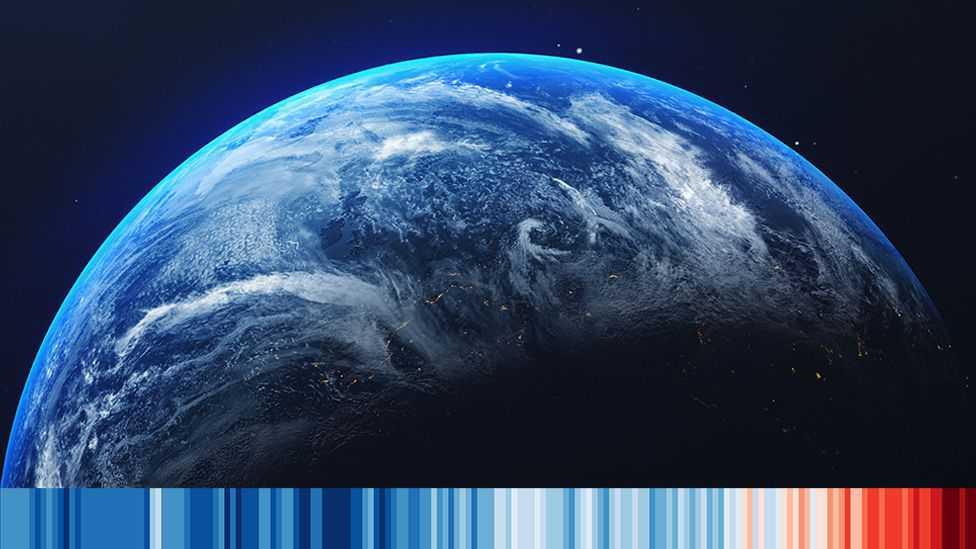What is climate change? A really simple guide

World temperatures are rising because of human activity, and climate change now threatens every aspect of human life.
Left unchecked, humans and nature will experience catastrophic warming, with worsening droughts, greater sea level rise and mass extinction of species.
We face a huge challenge, but there are potential solutions.
What is climate change?
Climate is the average weather in a place over many years. Climate change is a shift in those average conditions.
The rapid climate change we are now seeing is caused by humans using oil, gas and coal for their homes, factories and transport.
When these fossil fuels burn, they release greenhouse gases - mostly carbon dioxide (CO2). These gases trap the Sun's heat and cause the planet's temperature to rise.
The world is now about 1.2C warmer than it was in the 19th Century - and the amount of CO2 in the atmosphere has risen by 50%.
Temperature rises must slow down if we want to avoid the worst consequences of climate change, scientists say. They say global warming needs to be kept to 1.5C by 2100.
However, unless further action is taken, the planet could still warm by more than 2C by the end of this century.
If nothing is done, scientists think global warming could exceed 4C, leading to devastating heatwaves, millions losing their homes to rising sea levels and irreversible loss of plant and animal species.
What is the impact of climate change?
Extreme weather events are already more intense, threatening lives and livelihoods.
With further warming, some regions could become uninhabitable, as farmland turns into desert. In other regions, the opposite is happening, with extreme rainfall causing historic flooding - as seen recently in China, Germany, Belgium and the Netherlands.
People in poorer countries will suffer the most as they do not have the money to adapt to climate change. Many farms in developing countries already have to endure climates that are too hot and this will only get worse.
Our oceans and its habitats are also under threat. The Great Barrier Reef in Australia, for example, has already lost half of its corals since 1995 due to warmer seas driven by climate change.
Wildfires are becoming more frequent as climate change increases the risk of hot, dry weather.
And as frozen ground melts in places like Siberia, greenhouse gases trapped for centuries will be released into the atmosphere, worsening climate change.
In a warmer world, animals will find it harder to find the food and water they need to live. For example, polar bears could die out as the ice they rely on melts away, and elephants will struggle to find the 150-300 litres of water a day they need.
Scientists believe at least 550 species could be lost this century if action is not taken.
Coral reefIMAGE SOURCE,GETTY IMAGES
Image caption,If temperatures continue to rise, almost all warm water coral reefs could be destroyed
How will different parts of the world be affected?
Climate change has different effects in different areas of the world. Some places will warm more than others, some will receive more rainfall and others will face more droughts.
If temperature rise cannot be kept within 1.5C:
The UK and Europe will be vulnerable to flooding caused by extreme rainfall
Countries in the Middle East will experience extreme heatwaves and farmland could turn to desert
Island nations in the Pacific region could disappear under rising seas
Many African nations are likely to suffer droughts and food shortages
Drought conditions are likely in the western US, while other areas will see more intense storms
Australia is likely to suffer extremes of heat and drought
What are governments doing?
Countries agree climate change can only be tackled by working together, and in a landmark agreement in Paris in 2015, they pledged to try to keep global warming to 1.5C.
The UK is hosting a summit for world leaders, called COP26, in November, where countries will set out their carbon reduction plans for 2030.
Many countries have pledged to get to net zero by 2050. This means reducing greenhouse gas emissions as much as possible and balancing out remaining emissions by absorbing an equivalent amount from the atmosphere.
Experts agree that this is achievable, but it will require governments, businesses and individuals to make big changes.
What can individuals do?
Major changes need to come from governments and businesses, but scientists say some small changes in our lives can limit our impact on the climate:
Take fewer flights
Live car-free or use an electric car
Buy energy efficient products, such as washing machines, when they need replacing
Switch from a gas heating system to an electric heat pump
Insulate your home.
More on climate summit top strapline
The COP26 global climate summit in Glasgow in November is seen as crucial if climate change is to be brought under control. Almost 200 countries are being asked for their plans to cut emissions, and it could lead to major changes to our everyday lives.
Why the COP26 climate summit is important
What will climate change look like for you?
Will the UK meet its climate targets?
How extreme weather is linked to climate change
Previous Story
- Toyota testing hydrogen combustion engines in race cars
- Mitsubishi Shipbuilding successfully separates and captures CO2 from...
- Lofty prices for natural gas may fuel a...
- BPC plans to build an innovative LPG terminal...
- Gas-starved Bangladesh, one of the fastest-growing LNG markets...
- CPA may waive dues of LNG terminals, carriers
- Bangladesh compiling spot LNG shortlist
- Gas, tobacco segments: Tax income receipts drop in...